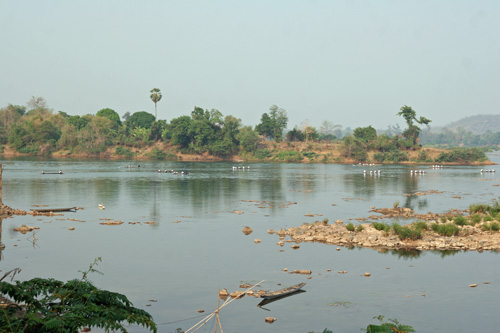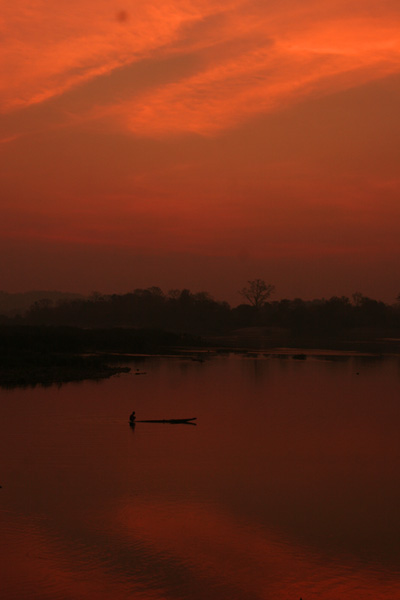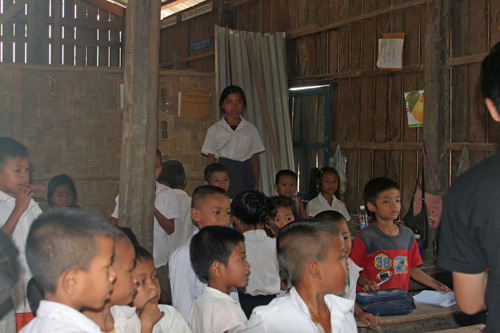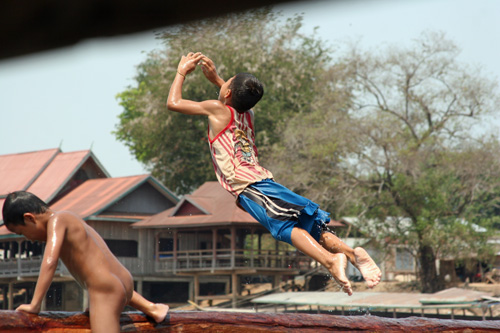At the South of Laos, where the Mekhong flows into Cambodia, there are said to be more than 4000 islands, so many that the flow of the river is almost completely blocked. There are narrow passages between the larger islands with strong rapids or even waterfalls, supposed to be spectacular. The channels between the islands are not navigable at all and therefore this creates a total blockage to shipping from the lower to the upper Mekhong.
We are staying on Don Khong, the larger of the islands, which means one more ferry – no not this one which is intended for motorcycles only.
After we settled into the hotel, I went for a walk around the small town of Muang Khong. Facing the ‘central park’ is a beautiful temple with a huge sitting Buddha – the first time I saw one in a temple sitting out in the open. The temple is called Wat Phuang Kaew. The water buffaloes are on their way to take a bath in the river.
I heard a school bell, and soon after that, the street filled with bicycles. I understood that here it actually pays to have a second person in the back of your bike if you are a girl, as that person can hold the umbrella for you, to make sure your skin stays as white as possible.
Not everybody rides their bicycle to school. There are obviously students who live across the river and have to row their canoes back home. The river filled with white dots as they all wear white shirts as school uniforms.
I was up before dawn the next day, around 5AM, and it was still totally dark outside. I was looking for the morning’s farmer’s market that is held here every day from dawn to 8 or 9 AM. It gave me a chance to see the sunrise; actually the colours and the sky were better even before the sun rose.
There is a lone fisherman playing the early bird. He probably already got the early worm, now he is trying to get the best fish.
The early morning silence was suddenly broken by a loud squeel followed by what I could only think of, at the time, as the dying cry of some animal somewhere. When I did make it to the market, I immediately understood what I had heard, as the butcher was still finishing the job. You cannot get fresher pork than this!
This is a local market for the local people. There were a few other tourists, like me, who were just looking around, but everybody else was either buying, or selling and some times both.
And it is not just food – you can buy all kinds of things here, in the early morning.
The whole place is a beehive of activity in the very early morning– do not let this picture fool you, it is still very dark at this time as the sun is barely up.
Back at the river, the sun is now visible as it has risen above the thick layer of smoke that is still present even here. The fisherman is still at work too, or is it another one? I cannot be sure.
I am unfortunately too late to catch the monks doing their morning food rounds. I catch them from a distance just before they go back to the monastery. Here, they seem to pray with the family after the food donation – I was too far to really understand what was going on. The group of monks stayed in this position, right next to the family, for 1-2 minutes before moving on.
The first rays of the sun give a totally different colour to the sitting Buddha of Wat Phuang Kaew – this one does not have the water buffaloes. If I were better with Photoshop, I would be able to copy the water buffaloes to this picture, and would have to show you one one! But that would be cheating, in a way.
Our visit of the area will continue with Don Det and Don Khon (not to be confused with Don Khong, where we stayed). These are two of the ‘barrier islands’ that block the Mekhong and are the most developed in the area. In order to get there, we take a small boat from Don Khong and work our way through smaller islands towards the South.
As I mentioned before, the water level in the Mekhong is very low right now. In this village, it provides additional land for growing crops right in the back of their houses, or is this the front? It is rather convenient as long as you can harvest before the rain starts again and the level of the river starts to go up.
As in Lake Inle, in Myanmar – see December 2008 for posts on and pictures from my trip to that country – water is an important transportation medium for the local people and boats are everywhere. As always, they are very friendly and wave as we go by.
A fisherman throwing a perfect circle with his net. This is one of many occasions when I wish to also have a video camera as the only way to really do justice to this scene is with full movement. I took several pictures of this particular throw, but that still does not give the full impression.
As we approach Don Det, we can see the efforts made by the French to circumvent the rapids in the river and allow transfer of goods from the upper Mekhong down to the lower river or vice-versa. They built a railway across Don Det and Don Khon, with loading docks at both ends. The large concrete structure in the middle of this picture was the end of the rail line on Don Det. This was not a major success and the system was not used for many years before it was abandoned.
We saw a class that was in session in the local school near the docks and our leader asked if he could speak to the class. He started to explain that most of the members of the tour came from Australia – this was done graphically as you can see.
The class was fascinated – there were six years into one classroom – these are the older students.
and these are the younger students, whom he addressed afterwards
I promised Tuy that I would send him the pictures I took. However, I am not sure that I have the correct email address for him. Tuy, if you read this, please let me know if you received my other notes, or comment on this post with the correct email address – thanks.
We went on towards the South of the islands, to try and see the waterfalls. There are small villages with peaceful rural scenes on the way
Now you will understand the reason why I said “supposed to be spectacular” when I referred to the rapids earlier on. You can only imagine what this looks like when it is full of roaring water. To give you an idea of scale, you can see a small blue dot near the river in the middle of the shot – that is the shirt of a man repairing his fishtrap. Even this low, the river is still close to 10 meters wide in the gorge.
A little further upstream, there are rapids, but nothing like what I had seen in pictures when the river flows normally. I will have to return to get the full impression.
This is the railroad bridge from Don Det to Don Kong. No longer used by the railroad, it is used by the locals to get to and from school, shopping etc – this is the rush hour as schools just closed for lunch..
The remnants of one of the locomotives used to move goods along the railroad.
As we headed back on the river towards the mainland, we found out that our landing spot was taken over by local kids – the river is an endless source of fun after school.
Not much of a dress code here; they just want to have fun.
Boys will be boys!
At least one of them has noticed our arrival and I am not sure she is very happy about it.
Smile for the camera!
It’s back to Vientiane for us and our last meal together. The local “Tiger Girl” with our beer!
I walked around some more and discovered more temples with intricate decorations. This one is not even listed in my guide book – too minor.
Along the river, there were men bowling – not the English kind of lawn bowling, but the french kind as is played in Provence – here it is called petang. As in France, there is a lot of discussion about who is closer to the ‘cochonnet’ (the little red target ball).
A player displaying perfect attacking form, making a hard shot to remove an opponent’s ball
More discussion
With finally a decision that placement is the way to go. In this case the answer to: “Alors, tu tires ou tu pointes!” (with a Provencale accent, of course) is: “Je pointe”. Notice that the player is standing in a bicycle tire to indicate the starting point!
That is it for Laos. It has been a wonderful two weeks.
(2602 Page Views)




































#pierreo An umbrella is an accessory. Would this make a girl as a second rider on a bicycle an accessory to an accessory?
She is actually the “Accessory Holder” – if you had a windscreen on a bike, she could use a suction cup, but without windscreen, have to use a girl!